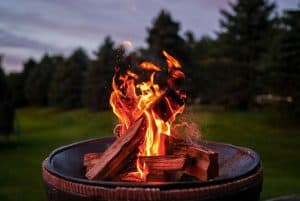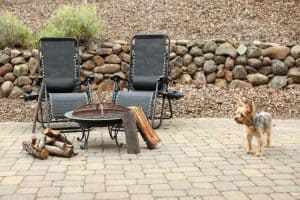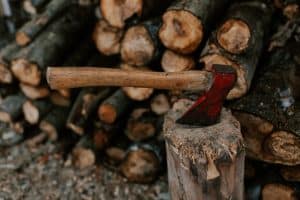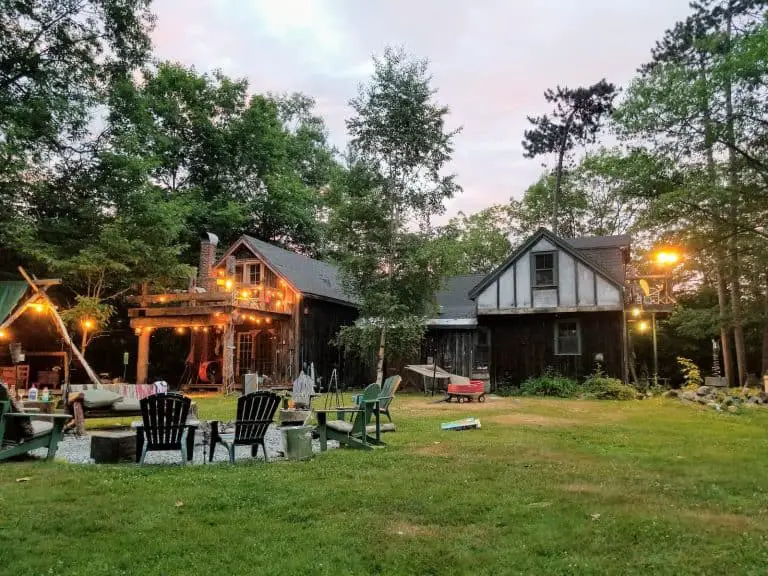Gathering around a crackling fire in the comfort of your own backyard can create some of the warmest memories. But as the popularity of at-home fire pits and outdoor fireplaces grows, so does the importance of backyard fire safety precautions. I’ll share with you essential tips to keep your property and loved ones safe.
From choosing the right location for your fire pit to understanding the types of wood that burn safely, knowing the do’s and don’ts is crucial. Stick around as I dive into the best practices that ensure your cozy nights remain both fun and hazard-free. Let’s make sure your next outdoor gathering is memorable for all the right reasons.
Choosing the Right Location for Your Fire Pit

When I’m planning an outdoor gathering, safety always comes first. I make it a point to brush up on backyard fire safety precautions to ensure my guests and property stay protected. The right choice in where to place my fire pit is a cornerstone of these measures.
Assessing the Right Spot for Safety and Comfort
Selecting the perfect spot needs a blend of safety and practicality. When it comes to backyard fire pits, wind direction and being properly ventilated are vital. A sheltered area might seem cozy, but it’s important to allow smoke and heat to disperse. I always look for a location where guests can enjoy the warmth without smoke blowing in their faces. Open spaces are best to avoid overhanging branches or other structures which could easily catch fire.
The ground on which the fire pit sits must be solid and fire-resistant. Portable fire pits have the advantage of flexibility, but they still need to be placed thoughtfully. Here’s what I make sure of:
- The surface beneath the pit is level, using metal, bricks, or sand to create a non-flammable base.
- The pit is a safe distance from my house and any wood deck, fencing, or yard playsets that are flammable materials.
- There’s water nearby to deal with any unexpected flames or embers.
Keeping Safety Front and Center with Proximity and Supervision
Outdoor fire safety isn’t just about the fire pit itself but also about the space around it. I guarantee there’s plenty of room for everyone to move around comfortably without the risk of tripping into the fire. This means keeping it at least 10 feet from any potential hazards, a handy tip I picked up from understanding wildland urban interface fires. The surrounding area needs to remain clear of dry leaves, dry grass, or anything that could accidentally ignite.
Maintaining fire prevention tips like having a fire extinguisher within reach, supervising children and pets meticulously, and never leaving the fire unattended are part of my routine. These simple actions work wonders for preventing accidents and ensuring everyone can relax and safely spend time outdoors.
Knowing the Types of Wood that Burn Safely

When it comes to ensuring backyard fire safety, choosing the right type of wood for your fire pit can be as crucial as any other fire prevention tip. It’s well understood that certain woods are safer to burn than others, and recognizing these can significantly minimize the risk associated with outdoor fires.
Optimizing Your Outdoor Fire Pit Experience
While tending to my own backyard fire pit, I’ve learned that the kind of wood I use plays a vital role in not just how the fire burns, but also in how safe the fireside experience is for myself and everyone around. Let’s dive into some of the specifics to consider.
For a start, good ol’ seasoned hardwoods such as oak and maple have always been my go-to choices. They burn longer, and I’ve noticed they ignite more evenly, producing a consistent and manageable flame. These hardwoods are perfect for a night of leisure by the fire pit, ensuring warmth and light for extended outdoor activities without the need for constant supervision.
On the flip side, softwoods like pine might seem alluring because they’re easy to find and quick to light. However, they’re not the best choice for an outdoor fire pit. Pine tends to burn at a fast rate, crackle, and pop, sending sparks and embers into the air. If you’ve got flammable materials or dry grass nearby, this is a sure recipe for unwanted wildland urban interface fires.
Navigating the Hazards of Improper Wood Choices
The prospect of just using that pile of leftover construction lumber may seem tempting, but it’s a bad idea. Pressure-treated woods or plywood may contain chemicals that release toxic smoke when burned. I’ve always made it a rule to avoid such materials as they pose a significant health risk and can easily taint the experience with unpleasant odors.
Moreover, staying informed about the local fire code is something I take seriously. There are times when my area’s fire code officials can order the extinguishing of fires that produce objectionable smoke or when conditions make fires hazardous. Safety is paramount after all.
Essential Tips for Fire Pit Safety
When it comes to backyard fire safety precautions, it’s vital to have a comprehensive plan in place. From choosing the right spot for your fire pit to understanding the dos and don’ts of outdoor fire safety, here’s what I’ve found works to create a secure environment for those cozy backyard gatherings.
Selecting the Right Spot for Your Fire Pit
I can’t stress enough how selecting the right location for your fire pit directly impacts safety. Whether you’re opting for permanent or portable fire pits, ensure there’s a safe distance of at least 10 feet from your house, wood deck, and other structures. I’ve often seen the aftermath of not keeping this distance, and it’s not pretty.
Always place your fire pit on a non-flammable surface like stone, brick, or concrete. When fires are set up on a wood deck or near dry grass, the risk of unwanted sparks turning into a full-blown fire is significant. Speaking from experience, it’s a bad idea to underestimate how far embers can travel.
I make it a rule to check for overhanging branches and anything in the surrounding area that could potentially catch fire. It’s not just the heat but also the embers and sparks that pose a danger, especially in wildland urban interface fires.
Fire Pit Safety Measures
Creating and maintaining a fire entails more than just sparking up some logs. Let me share some fire prevention tips that are second nature to me and should be for any responsible adult supervising an outdoor fire.
- Outdoor Fire Safety Measures: I always have tools like a fire extinguisher, fire blanket, or even a simple shovel to douse the flames in case of emergency.
- Take care of the wind direction; a gusty day can quickly spread sparks to unwanted places.
- Avoid using lighter fluid or other accelerants in wood burning fires; it’s not just unsafe, but it also ruins the natural taste of any food you might grill.
- For gas-powered pits, check the natural gas or propane connections regularly; leaks can be catastrophic.
Proper Handling and Storage of Firewood

When it comes to outdoor fires, particularly those in backyard fire pits, handling and storing firewood is a critical aspect of fire safety. My time spent researching and implementing backyard fire safety precautions has shown that the risks associated with firewood can be drastically reduced with a few smart practices.
Selecting the Right Firewood
The first step to ensuring your backyard blaze is a safe one involves being discerning about the firewood you use. Hardwoods like oak and ash have been my go-to choices because they burn cleaner and are less likely to cause a spark that could catch fire to the surrounding area. Softwoods like pine, on the other hand, can pop and send embers flying, potentially leading to a wildland urban interface fire if you live near wooded areas.
Safe Firewood Storage
Storing firewood correctly is as important as selecting the right type. I’ve found keeping a safe distance between my wood pile and other structures, including my house, sheds, and particularly anything made of wood like a wood deck, reduces the risk of fire spreading. A good rule of thumb is to store firewood at least 30 feet away from your home.
Avoiding Combustible Materials
It’s not just where you store your firewood that matters, but also what surrounds it. Ensuring there’s no dry grass or other flammable materials near your firewood pile is crucial. In previous years, I’ve seen how quickly a small spark can ignite these materials, and the resulting fires can be dangerous and destructive.
Fire Prevention Tips
Implementing outdoor fire safety measures and fire prevention tips doesn’t stop at the firewood. It’s vital to use a fire pit directly on a non-flammable surface and to always have water nearby—either a hose or a bucket of water—to douse the flames if necessary. And I can’t stress enough the importance of a good fire extinguisher—keeping one within arm’s reach has always been part of my safety protocol.
Ensuring Proper Ventilation and Fire Extinguishing Methods
One of the biggest concerns when dealing with outdoor fires—particularly in backyard settings—is ensuring there’s adequate ventilation. Properly ventilated areas help disperse smoke, reduce the accumulation of heat, and limit the risk of carbon monoxide buildup. Whether I’m working with a traditional outdoor fire pit or portable fire pits, I make it a point to verify that the location isn’t enclosed. Structures like wood decks or overhangs can trap heat and smoke, which are not just uncomfortable but dangerous.
In my experience, backyard fire safety hinges on having the right equipment to manage and extinguish the fire. I always have a fire extinguisher reachable within seconds, suited for the kind of fire I anticipate. For wood burning fires, I have a bucket of sand as well as water nearby to douse any escaping embers. With grill fires involving natural gas or propane, turning off the supply line is often the first step—only then do I smother the flames.
Backyard Fire Safety Precautions
- Keep the fire pit directly on a non-combustible surface away from dry grass and other structures. I maintain a safe distance—at least 10 feet—to reduce the chances of accidental damage or a fire spreading unexpectedly.
- Avoid flammable materials in the vicinity. Things like gasoline, lighter fluid, or piles of leaves can catch fire with the smallest spark.
- Always use a spark screen. The spark screen serves as a barrier for stray sparks that could turn a relaxing evening into a hazardous event.
- No matter how stable the flames seem, never leave the fire unattended. The wind direction can change swiftly, turning what was a controlled blaze into an uncontrollable hazard.
To protect oneself from unnecessary heat and prevent clothes from being burned, it’s a good idea to wear snug, non-flammable clothing instead of loose fitting clothing while tending a fire. I also ensure that all outdoor fire safety measures, such as backyard fire prevention tips and educating any participating in outdoor activities, are shared and understood.
Takeaway
Keeping your backyard gatherings safe and enjoyable means staying vigilant about fire safety. I’ve shared how critical it is to choose a safe location for your fire pit and the importance of being prepared with the right tools and knowledge. Remember to always monitor wind conditions avoid flammable liquids and ensure your gas connections are secure. With proper ventilation and the right extinguishing methods you’ll be set for a worry-free experience. By wearing the right clothing and educating your guests on fire safety you’re not just protecting your property but also the well-being of everyone around. Let’s keep the flames of fun burning safely so we can all enjoy countless cozy nights under the stars.
Other related articles:


